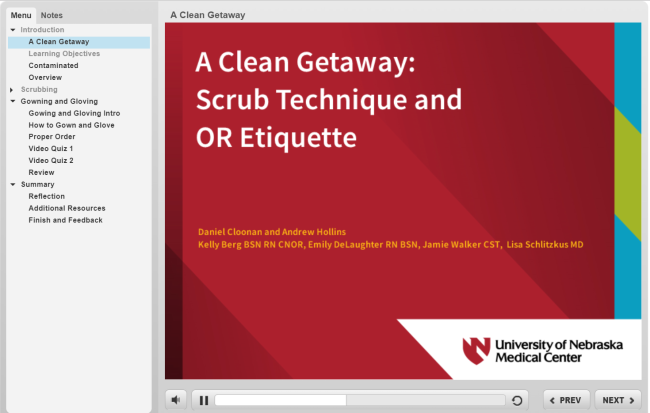You have /5 articles left.
Sign up for a free account or log in.

The opening slide of an elearning module created by two UNMC students.
University of Nebraska Medical Center
Alternative forms of teaching and learning are generally geared toward increasing students’ enthusiasm and capacity for absorbing the material. The University of Nebraska Medical Center thinks it's found a way to further that goal: directly involving students in the creation of learning materials.
The institution's E-Learning Program pairs students interested in creating online modules with faculty mentors and instructional designers who guide them through the process. A faculty-only stab at the initiative began in 2013, but eventually it refocused on students, putting them in control of material that ends up in their courses and online as constantly available resources.
"The idea is that some students learn differently," said Linda Sobeski, clinical assistant professor in the institution’s College of Pharmacy. "If we can offer them options for learning in different ways, that enhances the student learning experience."
Early Rumblings
The idea for the initiative first occurred to Dele Davies, the institution’s senior vice chancellor for academic affairs, in 2013 during a visit to campus from Richi Desai, a former Khan Academy executive, who discussed his view that students exhibit stronger outcomes when they’re involved in creating course material themselves.
That notion struck Davies as appealing but ambitious. He decided to start a new program with more modest aims: recruiting a couple of faculty members to create a handful of online modules to supplement their courses. The first cohort for that program was successful and quickly spawned a second. After each cohort, Davies and his team learned more about what works and what doesn’t in online modules -- how much audio to add, when transcripts are essential, how to keep branding consistent among disparate units.
By that point, the program was humming along, but Davies saw a need for evolution. Faculty members said modules took 100 hours or more to create. “Even though we were getting excellent feedback about the actual modules, only a few key people wanted to do it,” Davies said.
That’s when Davies came back around to the idea of utilizing students. The program’s third cohort consisted entirely of students, who were given free rein to create modules in subject areas of their interest. What came back were resources useful for many students that nonetheless strayed considerably from the curriculum.
On the fourth cohort, Davies reached what he sees as a happy medium: students and faculty members team up to create modules, with the former taking an active, or even leading, role.
“[Students] love it,” Davies said. “They all felt it helps them understand the work that it takes in teaching, what it takes to create the content.” Faculty members, meanwhile, get to work one on one with passionate students and create modules that serve them well in future semesters.
Typical modules last 20 minutes or less and include interactive elements. Key components include learning objectives, new content, quiz questions with instant feedback, and an option to review materials at the end. The narrow subject of each module means that students can pick and choose the ones they really care about, rather than having to wade through dense material they don’t need. Many modules fall within the field of anatomy, but they span relevant subject matter across all the institution’s colleges and institutes.
The program started with a few early adopters and spread through a model Davies calls “diffusion of innovation” -- success led to positive feelings among participants, who recommended it to their colleagues. Recruiting students worked similarly, particularly with the promise of a $1,000 stipend that funds the project and compensates them for their labor.
No Small Feat
Just as faculty members experienced challenges when embarking on new technological pursuits, students had mixed success early on. Some were surprised at how much work was required, even for a relatively simple slice of content.
“The ones who were really successful made plans over Thanksgiving and Christmas to put in a significant amount of time in that period,” said Peggy Moore, UNMC's director of elearning.
Daniel Cloonan, a fourth-year student pursuing a career in general surgery, was inspired to create a module after experiencing one too many “awkward situations” during his introduction to real operating rooms. Cloonan hadn’t yet been formally taught the process of donning gloves, scrubbing in, touching certain things and avoiding others -- but he felt these skills were important to know before students start real-world internships.
After teaming up with a fellow student and submitting an application, Cloonan recruited a faculty mentor who secured his group access to an official operating room for filming.
“We’re trying to make it very conversational. Students watching it are being led by someone, literally myself, who’s been through these embarrassing moments,” Cloonan said. “Every mistake you see in the module is a mistake I made in real life.”
Shooting took a day and a half, and editing took a week. The entire process from idea to execution took approximately seven months.
If he could do it again, Cloonan thinks there are parts of the video that might have been more effective as a hands-on lesson. But the experience gave him valuable curriculum-development skills that could be useful if he applies to work in places that value “learner-based development,” he said.
Why Faculty Wanted In
For faculty members like Sobeski, the E-Learning Program offered an opportunity to improve course material while developing closer bonds with standout students.
Sobeski recruited two of her pharmacy care students to create a module in fall 2015 explaining how to take a patient’s medical history. Together they created an outline for the project, and the students came up with language describing the justification for the learning module and its place in the curriculum.
“How to do something like interview a patient is difficult to explain in words. It’s much easier if they could see it,” Sobeski said. “I had tried several times before to look on the internet for sample videos of patient medication history interviews, and I couldn’t find anything that I liked. In this case we created one ourselves.”
The finished module seemed to reach students better than the “regular old dry didactic lecture” it replaced, Sobeski said. Students were able to explain it on a level other students could understand, whereas Sobeski thinks she sometimes skipped steps that were obvious to her but not to a novice.
In some cases, one elearning module experience prompted many more. Tanya Custer and Kim Michael teamed up with a student to create a module geared toward distance students in anatomy courses. The experience was so positive that the pair went on to create 53 more modules, even securing funding for their own instructional designer. Their original idea was for a couple of dozen modules, but Custer and Michael quickly realized that modules with narrower focus tend to be more successful than attempts to cram an entire subject into one lesson.
"It’s probably something Tanya and I would never have gotten into if the university would have put a call out for it," Michael said.
Why It Works
Modules are accessible on the institution’s public e-gallery page and in the learning management system. Some modules appear as mandatory assignments within courses, while others simply exist to serve students who need them on the spot.
The institution anecdotally reports that students respond well to the availability of the modules. It’s taken steps to seek more concrete data on that issue, now requiring participants in the program to meet with an evaluator to design an outcomes assessment for each new module. Eventually, Davies hopes, the institution will know how much time people spend on modules, where students are clicking within them and which aspects cause the most difficulties.
Student participation in the course development process seems like a minefield for intellectual property debate, but the institution insists it’s clear-cut: the university owns the module, though instructors can request to use it royalty-free if they move to a different institution.
Other institutions have expressed interest in partnering with Nebraska on the program, or at least sharing its fruits, according to Davies. UNMC is in the early stages of developing a partnership with George Washington University and the Mayo Clinic to develop an e-module on interprofessional education for use as a shared resource on all three campuses, Davies said.
Sobeski sees the elearning program as an important step in giving medical students the teaching skills they may find useful later in life.
“We’re health-care professionals who educate, but we love being in that environment and making that contribution to health care by developing the practitioners of the future,” Sobeski said. “Any time that we can develop a learner in a unique way is good.”








